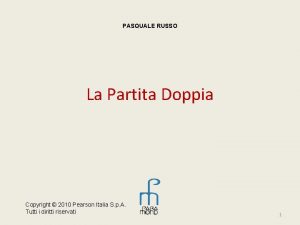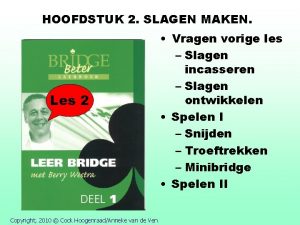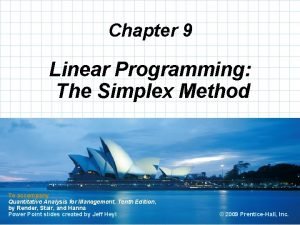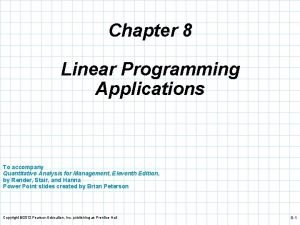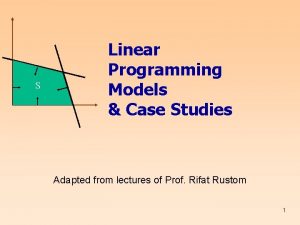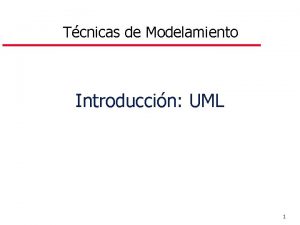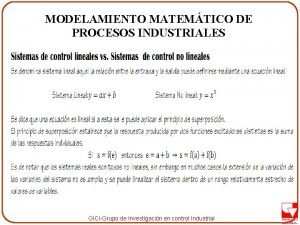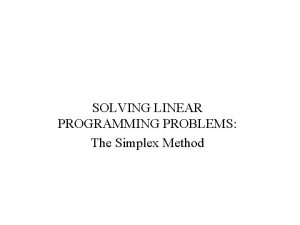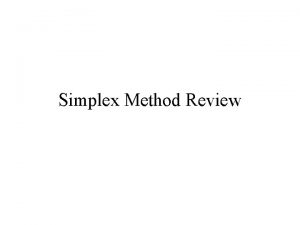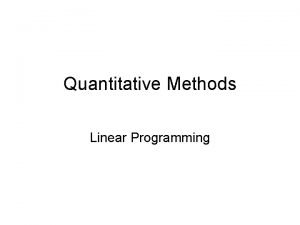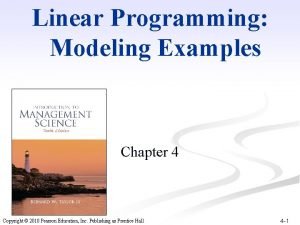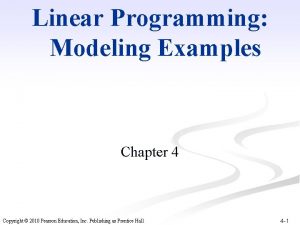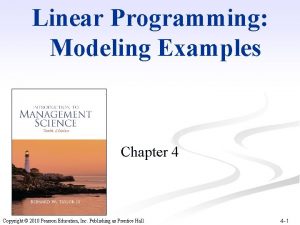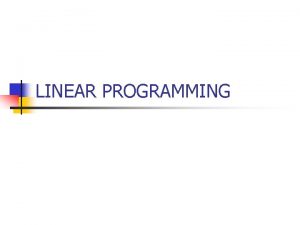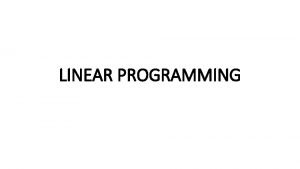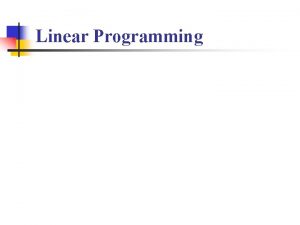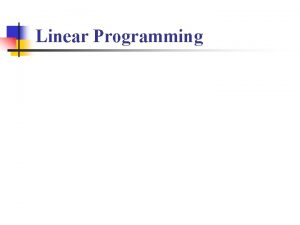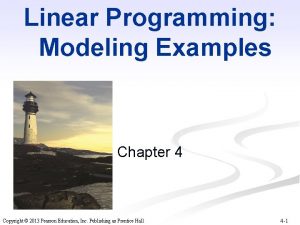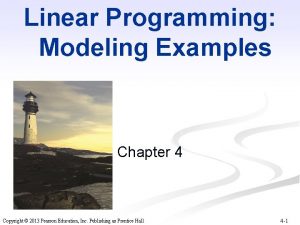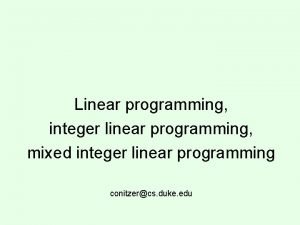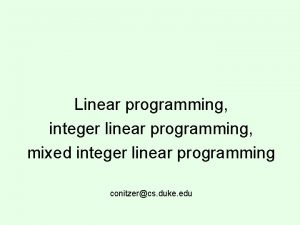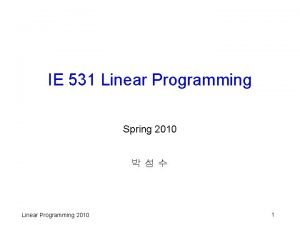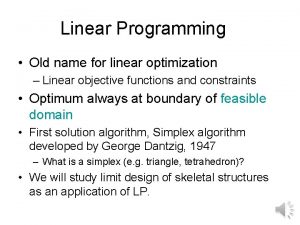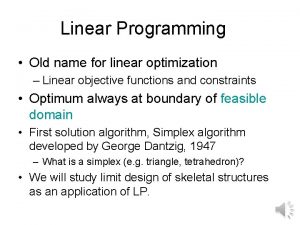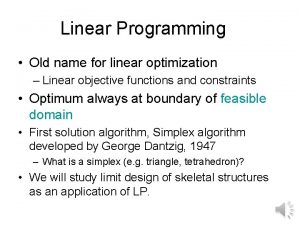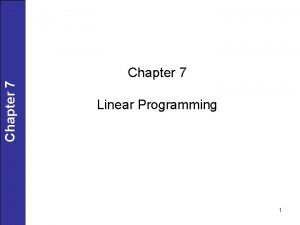Linear Programming Modeling Examples Chapter 4 Copyright 2010



































- Slides: 35

Linear Programming: Modeling Examples Chapter 4 Copyright © 2010 Pearson Education, Inc. Publishing as Prentice Hall 4 -1

Chapter Topics n A Product Mix Example n A Diet Example n An Investment Example n A Marketing Example n A Transportation Example n A Blend Example n A Multiperiod Scheduling Example Copyright © 2010 Pearson Education, Inc. Publishing as Prentice Hall 4 -2

A Product Mix Example Problem Definition (1 of 8) A 4 -product T-shirt/sweatshirt manufacturing company. ■ Must complete production within 72 hours ■ Truck capacity = 1, 200 standard sized boxes. ■ Standard size box holds 12 T-shirts. ■ A 12 -sweatshirts box is three times the size of a standard box. ■ $25, 000 available for a production run. ■ There are 500 dozen blank T-shirts and sweatshirts in stock. ■ How many dozens (boxes) of each type of shirt to produce? ■ T-shirt with Front Print ■ T-shirt with Front and Back Print ■ Sweatshirt with Front and Back Print 4 -3

A Product Mix Example (2 of 8) Copyright © 2010 Pearson Education, Inc. Publishing as Prentice Hall 4 -4

A Product Mix Example Data (3 of 8) Copyright © 2010 Pearson Education, Inc. Publishing as Prentice Hall 4 -5

A Product Mix Example Model Construction (4 of 8) Decision Variables: x 1 = sweatshirts, front printing x 2 = sweatshirts, back and front printing x 3 = T-shirts, front printing x 4 = T-shirts, back and front printing Objective Function: Maximize Z = $90 x 1 + $125 x 2 + $45 x 3 + $65 x 4 Model Constraints: 0. 10 x 1 + 0. 25 x 2+ 0. 08 x 3 + 0. 21 x 4 72 hr 3 x 1 + 3 x 2 + x 3 + x 4 1, 200 boxes $36 x 1 + $48 x 2 + $25 x 3 + $35 x 4 $25, 000 x 1 + x 2 500 dozen sweatshirts x 3 + x 4 500 dozen T-shirts Copyright © 2010 Pearson Education, Inc. Publishing as Prentice Hall 4 -6

A Product Mix Example Solution with QM for Windows (7 of 8) Copyright © 2010 Pearson Education, Inc. Publishing as Prentice Hall Exhibit 4. 3 4 -7

A Product Mix Example Solution with QM for Windows (8 of 8) Copyright © 2010 Pearson Education, Inc. Publishing as Prentice Hall Exhibit 4. 4 4 -8

A Diet Example Data and Problem Definition (1 of 5) Breakfast to include at least 420 calories, 5 milligrams of iron, 400 milligrams of calcium, 20 grams of protein, 12 grams of fiber, and must have no more than 20 grams of fat and 30 milligrams of cholesterol. Copyright © 2010 Pearson Education, Inc. Publishing as Prentice Hall 4 -9

A Diet Example Model Construction – Decision Variables (2 of 5) x 1 = cups of bran cereal x 2 = cups of dry cereal x 3 = cups of oatmeal x 4 = cups of oat bran x 5 = eggs x 6 = slices of bacon x 7 = oranges x 8 = cups of milk x 9 = cups of orange juice x 10 = slices of wheat toast Copyright © 2010 Pearson Education, Inc. Publishing as Prentice Hall 4 -10

A Diet Example Model Summary (3 of 5) Minimize Z = 0. 18 x 1 + 0. 22 x 2 + 0. 10 x 3 + 0. 12 x 4 + 0. 10 x 5 + 0. 09 x 6 + 0. 40 x 7 + 0. 16 x 8 + 0. 50 x 9 + 0. 07 x 10 subject to: 90 x 1 + 110 x 2 + 100 x 3 + 90 x 4 + 75 x 5 + 35 x 6 + 65 x 7 + 100 x 8 + 120 x 9 + 65 x 10 420 calories 2 x 2 + 2 x 3 + 2 x 4 + 5 x 5 + 3 x 6 + 4 x 8 + x 10 20 g fat 270 x 5 + 8 x 6 + 12 x 8 30 mg cholesterol 6 x 1 + 4 x 2 + 2 x 3 + 3 x 4+ x 5 + x 7 + x 10 5 mg iron 20 x 1 + 48 x 2 + 12 x 3 + 8 x 4+ 30 x 5 + 52 x 7 + 250 x 8 + 3 x 9 + 26 x 10 400 mg of calcium 3 x 1 + 4 x 2 + 5 x 3 + 6 x 4 + 7 x 5 + 2 x 6 + x 7 + 9 x 8+ x 9 + 3 x 10 20 g protein 5 x 1 + 2 x 2 + 3 x 3 + 4 x 4+ x 7 + 3 x 10 12 xi 0, for all j Copyright © 2010 Pearson Education, Inc. Publishing as Prentice Hall 4 -11

An Investment Example $70, 000 to divide between several investments • Municipal bonds – 8. 5% annual return • Certificates of deposit – 5%33 • Treasury bills – 6. 5% • Growth stock fund – 13% -No more than 20% of investment should be in Municipal Bonds - The amount invested in deposit cannot exceed the amount invested in the other three alternatives. - At least 30% in treasury bills and deposit - More should be invested in deposits and treasury bills than in bonds and funds; the ratio should be at least 1. 2 to 1. where x 1 = amount ($) invested in municipal bonds x 2 = amount ($) invested in certificates of deposit x 3 = amount ($) invested in treasury bills x 4 = amount ($) invested in growth stock fund 4 -12

An Investment Example Model Summary (1 of 4) Maximize Z = $0. 085 x 1 + 0. 05 x 2 + 0. 065 x 3+ 0. 130 x 4 subject to: x 1 $14, 000 x 2 - x 1 - x 3 - x 4 0 x 2 + x 3 $21, 000 -1. 2 x 1 + x 2 + x 3 - 1. 2 x 4 0 x 1 + x 2 + x 3 + x 4 = $70, 000 x 1, x 2, x 3, x 4 0 where x 1 = amount ($) invested in municipal bonds x 2 = amount ($) invested in certificates of deposit x 3 = amount ($) invested in treasury bills x 4 = amount ($) invested in growth stock fund Copyright © 2010 Pearson Education, Inc. Publishing as Prentice Hall 4 -13

A Marketing Example (The Biggs Dept. Store Chain hires an advertising firm)) Data and Problem Definition (1 of 6) § Budget limit $100, 000 § Television time available for 4 commercials § Radio time for 10 commercials § Newspaper space for 7 ads § Resources available for no more than 15 commercials and/or ads Copyright © 2010 Pearson Education, Inc. Publishing as Prentice Hall 4 -14

A Marketing Example Model Summary (2 of 6) Maximize Z = 20, 000 x 1 + 12, 000 x 2 + 9, 000 x 3 subject to: 15, 000 x 1 + 6, 000 x 2+ 4, 000 x 3 100, 000 x 1 4 x 2 10 x 3 7 x 1 + x 2 + x 3 15 x 1, x 2, x 3 0 where x 1 = number of television commercials x 2 = number of radio commercials x 3 = number of newspaper ads Copyright © 2010 Pearson Education, Inc. Publishing as Prentice Hall 4 -15

Copyright © 2010 Pearson Education, Inc. Publishing as Prentice Hall 4 -16

Copyright © 2010 Pearson Education, Inc. Publishing as Prentice Hall 4 -17

A Transportation Example (Zephyr TV Comp. ) Problem Definition and Data (1 of 3) Warehouse supply of Television Sets: Retail store demand for television sets: 1 - Cincinnati 300 A - New York 150 2 - Atlanta 200 B - Dallas 250 3 - Pittsburgh 200 C - Detroit 200 Total 700 Total 600 Copyright © 2010 Pearson Education, Inc. Publishing as Prentice Hall 4 -18

A Transportation Example Model Summary (2 of 4) Minimize Z = $16 x 1 A + 18 x 1 B + 11 x 1 C + 14 x 2 A + 12 x 2 B + 13 x 2 C + 13 x 3 A + 15 x 3 B + 17 x 3 C subject to: x 1 A + x 1 B+ x 1 C 300 x 2 A+ x 2 B + x 2 C 200 Double-subscripted variable: xij : Number of products shipped from warehouse i to store j, for i=1, 2, 3 and j=A, B, C. x 3 A+ x 3 B + x 3 C 200 x 1 A + x 2 A + x 3 A = 150 x 1 B + x 2 B + x 3 B = 250 x 1 C + x 2 C + x 3 C = 200 All xij 0 Copyright © 2010 Pearson Education, Inc. Publishing as Prentice Hall 4 -19

Copyright © 2010 Pearson Education, Inc. Publishing as Prentice Hall 4 -20

Copyright © 2010 Pearson Education, Inc. Publishing as Prentice Hall 4 -21

Copyright © 2010 Pearson Education, Inc. Publishing as Prentice Hall 4 -22

A Blend Example (A petroleum company produces three grades of motor oil from three components) Problem Definition and Data (1 of 6) Copyright © 2010 Pearson Education, Inc. Publishing as Prentice Hall 4 -23

A Blend Example Problem Statement and Variables (2 of 6) ■ Determine the optimal mix of the three components in each grade of motor oil that will maximize profit. Company wants to produce at least 3, 000 barrels of each grade of motor oil. ■ Decision variables: The quantity of each of the three components used in each grade of gasoline (9 decision variables) xij = barrels of component i used in motor oil grade j per day, where i = 1, 2, 3 and j = s (super), p (premium), and e (extra). Copyright © 2010 Pearson Education, Inc. Publishing as Prentice Hall 4 -24

A Blend Example Model Summary (3 of 6) Maximize Z = 11 x 1 s + 13 x 2 s + 9 x 3 s + 8 x 1 p + 10 x 2 p + 6 x 3 p + 6 x 1 e + 8 x 2 e + 4 x 3 e subject to: x 1 s + x 1 p + x 1 e 4, 500 bbl. x 2 s + x 2 p + x 2 e 2, 700 bbl. x 3 s + x 3 p + x 3 e 3, 500 bbl. 0. 50 x 1 s - 0. 50 x 2 s - 0. 50 x 3 s 0 0. 70 x 2 s - 0. 30 x 1 s - 0. 30 x 3 s 0 0. 60 x 1 p - 0. 40 x 2 p - 0. 40 x 3 p 0 0. 75 x 3 p - 0. 25 x 1 p - 0. 25 x 2 p 0 0. 40 x 1 e- 0. 60 x 2 e- - 0. 60 x 3 e 0 0. 90 x 2 e - 0. 10 x 1 e - 0. 10 x 3 e 0 x 1 s + x 2 s + x 3 s 3, 000 bbl. x 1 p+ x 2 p + x 3 p 3, 000 bbl. all xij 0 x 1 e+ x 2 e + x 3 e 3, 000 bbl. Copyright © 2010 Pearson Education, Inc. Publishing as Prentice Hall 4 -25

Solution for Blend Example n n n n X 1 s = 1500 barrels X 2 s = 600 barrels X 3 s = 900 barrels X 1 p = 1200 barrels X 2 p = 1800 barrels X 1 e = 1800 barrels X 2 e = 1300 barrels X 3 e = 900 barrels Z = $76800 Copyright © 2010 Pearson Education, Inc. Publishing as Prentice Hall 4 -26

A Multi-Period Scheduling Example Problem Definition and Data (1 of 5) Production Capacity: 160 computers per week 50 more computers with overtime Assembly Costs: $190 per computer regular time; $260 per computer overtime Inventory Holding Cost: $10/computer per week Order schedule: Copyright © 2010 Pearson Education, Inc. Publishing as Prentice Hall 4 -27

A Multi-Period Scheduling Example Decision Variables (2 of 5) Decision Variables: rj = regular production of computers in week j (j = 1, 2, …, 6) oj = overtime production of computers in week j (j = 1, 2, …, 6) ij = extra computers carried over as inventory in week j (j = 1, 2, …, 5) Copyright © 2010 Pearson Education, Inc. Publishing as Prentice Hall 4 -28

A Multi-Period Scheduling Example Model Summary (3 of 5) Model summary: Minimize Z = $190(r 1 + r 2 + r 3 + r 4 + r 5 + r 6) + $260(o 1+o 2 +o 3 +o 4+o 5+o 6) + 10(i 1 + i 2 + i 3 + i 4 + i 5) subject to: rj 160 computers in week j (j = 1, 2, 3, 4, 5, 6) oj 50 computers in week j (j = 1, 2, 3, 4, 5, 6) r 1 + o 1 - i 1 = 105 week 1 r 2 + o 2 + i 1 - i 2 = 170 week 2 r 3 + o 3 + i 2 - i 3 = 230 week 3 r 4 + o 4 + i 3 - i 4 = 180 week 4 r 5 + o 5 + i 4 - i 5 = 150 week 5 r 6 + o 6 + i 5 = 250 week 6 rj, oj, ij 0 Copyright © 2010 Pearson Education, Inc. Publishing as Prentice Hall 4 -29

Slotion for Multi-Period Scheduling Example n n n n r 1 = 160 computers produced in regular time in week 1 r 2 = 160 computers produced in regular time in week 2 r 3 = 160 computers produced in regular time in week 3 r 4 = 160 computers produced in regular time in week 4 r 5= 160 computers produced in regular time in week 5 r 6 = 160 computers produced in regular time in week 6 o 3 = 25 computer produced with overtime in week 3 o 4 = 20 computer produced with overtime in week 4 o 5 = 30 computer produced with overtime in week 5 o 6 = 50 computer produced with overtime in week 6 i 1 = 55 computers carried over in inventory in week 1 i 2 = 45 computers carried over in inventory in week 2 i 5 = 40 computers carried over in inventory in week 5 Copyright © 2010 Pearson Education, Inc. Publishing as Prentice Hall 4 -30

Example Problem Solution Problem Statement and Data (1 of 5) Canned cat food - Meow Chow; dog food - Bow Chow. ■ Ingredients/week: 600 lb horse meat; 800 lb fish; 1000 lb cereal. ■ Recipe requirement: Meow Chow at least half fish Bow Chow at least half horse meat. ■ 2, 250 units of 16 -ounce cans available each week. ■ Profit /can: Meow Chow $0. 80 Bow Chow $0. 96. How many cans of Bow Chow and Meow Chow should be produced each week in order to maximize profit? Copyright © 2010 Pearson Education, Inc. Publishing as Prentice Hall 4 -31

Example Problem Solution Model Formulation (2 of 5) Step 1: Define the Decision Variables xij = ounces of ingredient i in pet food j per week, where i = h (horse meat), f (fish) and c (cereal), and j = m (Meow chow) and b (Bow Chow). Step 2: Formulate the Objective Function Maximize Z = $0. 05(xhm + xfm + xcm) + 0. 06(xhb + xfb + xcb) Copyright © 2010 Pearson Education, Inc. Publishing as Prentice Hall 4 -32

Example Problem Solution Model Formulation (3 of 5) Step 3: Formulate the Model Constraints Amount of each ingredient available each week: xhm + xhb 9, 600 ounces of horse meat xfm + xfb 12, 800 ounces of fish xcm + xcb 16, 000 ounces of cereal additive Recipe requirements: Meow Chow: xfm/(xhm + xfm + xcm) 1/2 or - xhm + xfm- xcm 0 Bow Chow: xhb/(xhb + xfb + xcb) 1/2 or xhb- xfb - xcb 0 Can Content: xhm + xfm + xcm + xhb + xfb+ xcb 36, 000 ounces Copyright © 2010 Pearson Education, Inc. Publishing as Prentice Hall 4 -33

Example Problem Solution Model Summary (4 of 5) Step 4: Model Summary Maximize Z = $0. 05 xhm + $0. 05 xfm + $0. 05 xcm + $0. 06 xhb + 0. 06 xfb + 0. 06 xcb subject to: xhm + xhb 9, 600 ounces of horse meat xfm + xfb 12, 800 ounces of fish xcm + xcb 16, 000 ounces of cereal additive - xhm + xfm- xcm 0 xhb- xfb - xcb 0 xhm + xfm + xcm + xhb + xfb+ xcb 36, 000 ounces xij 0 Copyright © 2010 Pearson Education, Inc. Publishing as Prentice Hall 4 -34

Example Problem Solution with QM for Windows (5 of 5) Copyright © 2010 Pearson Education, Inc. Publishing as Prentice Hall 4 -35
 Perbedaan linear programming dan integer programming
Perbedaan linear programming dan integer programming Linear vs integer programming
Linear vs integer programming Definisi linear
Definisi linear Modeling role modeling theory
Modeling role modeling theory Relational modeling vs dimensional modeling
Relational modeling vs dimensional modeling Copyright 2010 pearson education inc
Copyright 2010 pearson education inc Copyright 2010
Copyright 2010 Variazioni finanziarie attive e passive
Variazioni finanziarie attive e passive Copyright 2010 pearson education inc
Copyright 2010 pearson education inc Copyright 2010 pearson education inc
Copyright 2010 pearson education inc Copyright 2010
Copyright 2010 Nwoz
Nwoz Copyright 2010 pearson education inc
Copyright 2010 pearson education inc Copyright 2010 pearson education inc
Copyright 2010 pearson education inc Copyright 2010 pearson education inc
Copyright 2010 pearson education inc Copyright 2010 pearson education inc
Copyright 2010 pearson education inc Copyright 2010 pearson education inc
Copyright 2010 pearson education inc Composition copyright example
Composition copyright example Copyright 2010 pearson education inc
Copyright 2010 pearson education inc The zj row in a simplex table for maximization represents
The zj row in a simplex table for maximization represents Linear programming models: graphical and computer methods
Linear programming models: graphical and computer methods Chapter 8 linear programming applications solutions
Chapter 8 linear programming applications solutions Sensitivity report interpretation
Sensitivity report interpretation Flair furniture company linear programming
Flair furniture company linear programming Modeling with quadratic functions
Modeling with quadratic functions Hlm hierarchical linear modeling
Hlm hierarchical linear modeling Control de nivel de tanque
Control de nivel de tanque Disadvantages of multimedia
Disadvantages of multimedia Greedy vs dynamic programming
Greedy vs dynamic programming System programming
System programming Simplex method problem
Simplex method problem Difference constraints and shortest paths
Difference constraints and shortest paths Canonical form of linear programming problem
Canonical form of linear programming problem Linear programming in quantitative techniques
Linear programming in quantitative techniques Scope of linear programming
Scope of linear programming Network model linear programming
Network model linear programming







